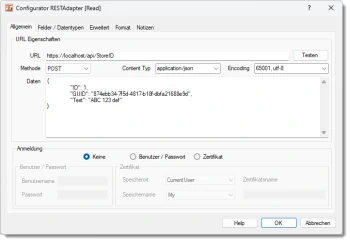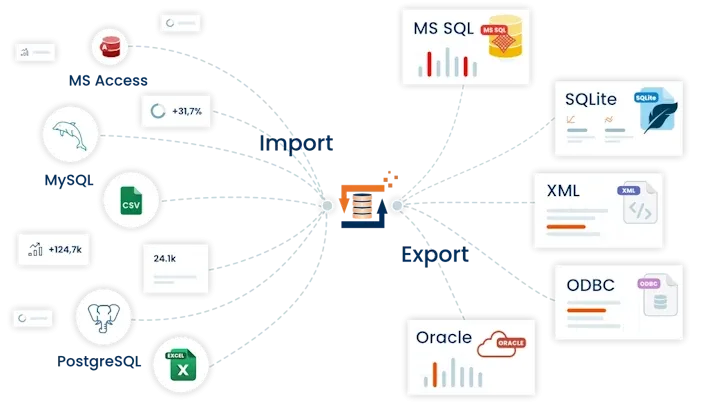REST API Adapter - Calling HTTP RESTful Web Services
The REST API Adapter can be used for calling dynamically HTTP RESTful API web services. Standard calling methods GET, POST, PUT, PATCH and DELETE are supported. It is possible to use the REST API Adapter on both READ and WRITE sides.
The REST adapter can be adapted for any individual request. Requests can be sent dynamically and evaluated automatically via stacked processing steps. See the examples below.
General tab
 Adapter REST - GeneralThe standard configuration is defined in the General tab. Here you specify which URL should be called, using which method and whether a login to the web server should take place.
Adapter REST - GeneralThe standard configuration is defined in the General tab. Here you specify which URL should be called, using which method and whether a login to the web server should take place.
URL: Enter here the URL to be accessed.
Method: The HTTP method to be used. Possible methods are GET, POST, PUT, PATCH and DELETE.
Content Type: If a type is specified here, the HTTP header field "Content-Type" is set to this media type along with the selected encoding (charset). For example: “Content-Type: application/json; charset=utf-8”
Note: HTTP content/request header variable “Content-Type” can also be set dynamically according to Adapter fields. See the "Fields / Data types" tab.
Data: The request content to be sent, typically via the “POST” HTTP method. The request content can also be set dynamically via Adapter fields. See the "Fields / Data types" tab.
Warning: When you invoke the REST API using the "Test" button, the specified call is transmitted to the web server. You should always use a separate test URL for while experimenting to prevent unintended changes or additions to and deletions of your data.
Login
The REST Adapter supports user login to the web server via a username and password combination as well as via a user certificate stored in the Windows certificate store. Note: A private key must be stored in the certificate to enable login via certificate.
Fields / Data types tab
 Adapter REST - Fields / data typesYou can use this tab to dynamically set or retrieve values, depending on whether you are using the REST API Adapter on the "READ" or "WRITE" side.
Adapter REST - Fields / data typesYou can use this tab to dynamically set or retrieve values, depending on whether you are using the REST API Adapter on the "READ" or "WRITE" side.
Field type: Use the field type to specify which value is to be set or called via the REST API call. The following options are available:
URL: Overwrites the entry made in the "General" tab.
Agent: Sets the Request Header variable "User-Agent" to the value specified.
HTTP_STATUS: The status code returned by the web server in text form, such as one of “OK”, “Accepted” or “Not Found”
HTTP_STATUS_CODE: The status code number returned by the web server, such as one of 200, 202 or 404
RequestDateTime: Date and time of the request
RequestHeader: Sets an HTTP header variable with format "Name=Fieldname" to the current value of the field.
RequestContent: Transmits the value of the field as content. This overrides the content specified under Data in the General tab.
RequestContentHeader: Sets an HTTP CONTENT HEADER variable in the format "Name=Fieldname" to the current value of the field.
ResponseDateTime: Date and time of the web server’s response.
ResponseHeader: Retrieves the HTTP RESPONSE HEADER variables supplied by the web server. If the option "Return with field names" is checked , all HEADER variables supplied are returned including their names.
ResponseContent: The content delivered by the web server. For example, in JSON, XML or HTML format.
ResponseContentHeader: Retrieves the HTTP RESPONSE CONTENT HEADER variables supplied by the web server. If the option "Returned by field name" is checked , all CONTENT HEADER variables supplied are returned including their names .
Advanced tab
 Adapter REST - AdvancedRequest timeout: Defines the maximum amount of time to wait for a response from the REST web service. The number entered here is in milliseconds.
Adapter REST - AdvancedRequest timeout: Defines the maximum amount of time to wait for a response from the REST web service. The number entered here is in milliseconds.
Verify SSL/TLS certificates: When this option is checked, the certificate supplied by the web server is validated. Note: This option should only be unchecked in exceptional circumstances.
Read from: When the REST API adapter is used on the WRITE side, what is written can be accessed by a subsequent processing step. This way, all subsequent REST web service requests made are read and the status or delivered content for each request can be processed.
Adapter settings in the Format tab
The use of the Format tab is described in detail under general information about the usage of Adapters
The following examples are available for the REST API Adapter
- Support forum article (only in German)
- More examples will follow shortly

